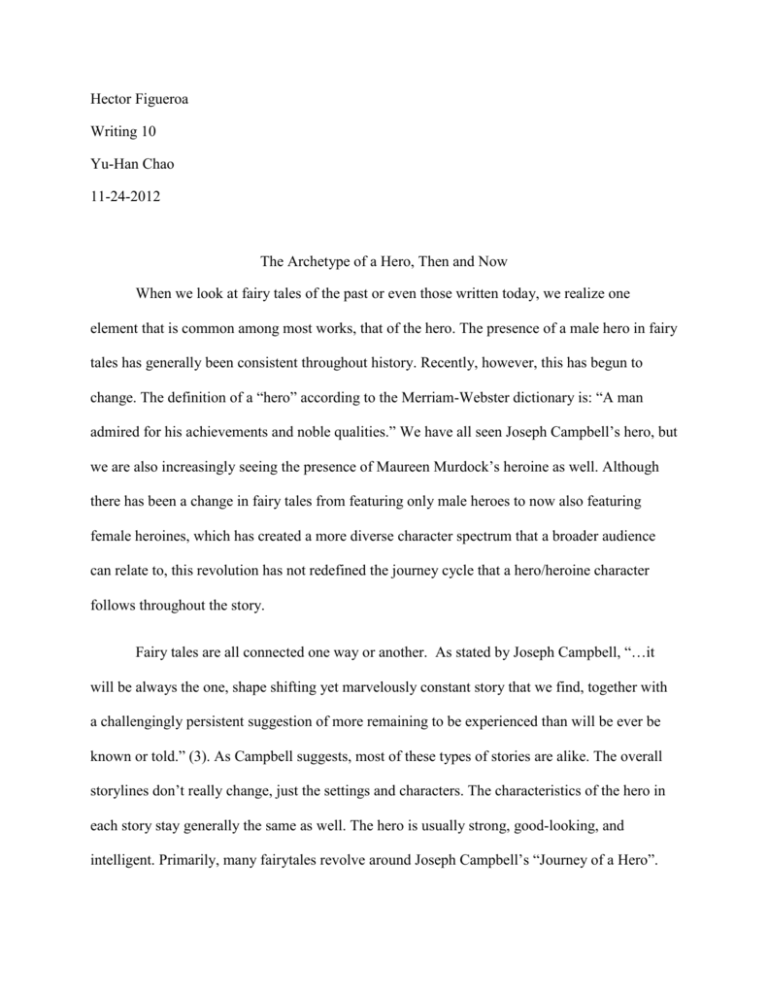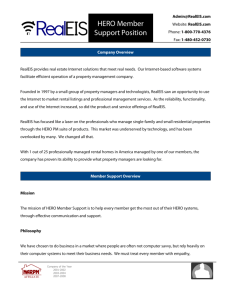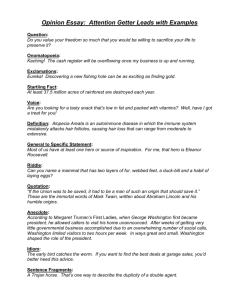Hector Figueroa Writing 10 Yu-Han Chao 11-24
advertisement

Hector Figueroa Writing 10 Yu-Han Chao 11-24-2012 The Archetype of a Hero, Then and Now When we look at fairy tales of the past or even those written today, we realize one element that is common among most works, that of the hero. The presence of a male hero in fairy tales has generally been consistent throughout history. Recently, however, this has begun to change. The definition of a “hero” according to the Merriam-Webster dictionary is: “A man admired for his achievements and noble qualities.” We have all seen Joseph Campbell’s hero, but we are also increasingly seeing the presence of Maureen Murdock’s heroine as well. Although there has been a change in fairy tales from featuring only male heroes to now also featuring female heroines, which has created a more diverse character spectrum that a broader audience can relate to, this revolution has not redefined the journey cycle that a hero/heroine character follows throughout the story. Fairy tales are all connected one way or another. As stated by Joseph Campbell, “…it will be always the one, shape shifting yet marvelously constant story that we find, together with a challengingly persistent suggestion of more remaining to be experienced than will be ever be known or told.” (3). As Campbell suggests, most of these types of stories are alike. The overall storylines don’t really change, just the settings and characters. The characteristics of the hero in each story stay generally the same as well. The hero is usually strong, good-looking, and intelligent. Primarily, many fairytales revolve around Joseph Campbell’s “Journey of a Hero”. The journey of a hero is what makes up the story and is the cycle that the hero embarks on. This journey can be broken down into three parts, which include the departure, initiation, and return (Campbell ix). The departure is how the journey starts off and it gives the reasons as to why the hero decides to leave home. The first stage of the departure is “The Call to Adventure” (Campbell 49). In this stage, the hero is found by a secondary character by chance, and this character asks for the hero’s help. This is then followed by the second stage, which is the “Refusal of the Call” (59). When given the task to help another, the hero will tend to be preoccupied with some other obligation and will simply look the other way. However, some mystical power beyond the hero’s control will persuade him to move forward with the path that was laid before him. In the third stage, as described by Campbell, “…the first encounter of the hero journey is with a protective figure (often a little old crone or old man) who provides the adventurer with amulets…” (69). This part of the stage is known as “Super Natural Aid”. The fourth stage, known as “Crossing the Threshold” (77), is when the hero is saved or protected by the super natural aid given to him earlier. Finally, the last part of this group is called “The Belly of the Whale” (90). This part of the story is when the hero is thrown into some unknown area. He may have some other form of aid, but he is without his mentor. The second part of the hero’s journey is known as the Initiation, which usually shows the hero’s journey after leaving his home. The first stage is the “Road of Trials” (Campbell 97). Here, the hero moves into an unknown world where he must survive a number of trials. “Meeting with the Goddess” (109) is usually the second stage of Initiation. In fairy tales, this is when the hero meets the princess for the first time. The third stage is the “Woman as the Temptress” (120). During this stage, “the mystical marriage with the queen goddess of the world represents the hero’s total mastery of life…” (120). The hero must choose whether to stay on his current path or deviate for other reasons. “Apotheosis” is the next stage of Initiation. This is when the hero understands what his purpose in life is, so he places others before himself (149). The last stage, “The Ultimate Boon”, is when the hero has accomplished his task. He then shares all of his knowledge with others. (192). After the hero’s initial quest has been completed, the first stage of his return is called the “Refusal of the Return” (Campbell 193). The hero does not want to leave the new world that he has grown to like. Next, “The Magic Flight” explains how the hero stays in the new world until a certain “fallen group” is fully restored, such as an important village being rebuilt. “Rescue from Without” is when the hero is faced with a final challenge from which he is rescued or saved by some unexpected source, such as a character from earlier on in the story or a god. Before coming home though, the hero must pass through the fourth stage, which is the “The Crossing of the Return Threshold” (217). This part signifies when the hero is content with the outcome of his journey and begins his travel home. The next stage is the “Master of the Two Worlds”. This is when the hero is congratulated for his accomplishments. Finally, the hero’s journey comes to an end with “Freedom to Live”, when the hero comes to understand both worlds and how important he was in each of them (Campbell 239). If we look at the life of “hero” Luke Skywalker from the Star Wars saga as an example, we can easily see how the Journey of a Hero plays into this storyline cycle quite well. Luke is the unexpected hero, the underdog. It all begins with Luke being born under extraordinary circumstances, since he is the offspring of one of the most powerful Jedi that has ever lived, Darth Vader. As a teenager, Luke witnesses the Call to Adventure when Princess Leia seeks his help. He initially rejects the call to go to Alderaan with Obi Wan Kenobi, but ultimately accepts the adventure after the storm troopers kill both his aunt and uncle. Once he accepts his call, he then is taken under the wing of Obi Wan, who symbolizes Luke’s “Super Natural Aid”. Before their Journey starts, they begin to cross their first threshold, which happens to be the Mos Eisley’s Bar. Luke is saved by his mentor from a couple of thugs. In order to save the Leia, Luke and his companions enter the death star, which is meant to resemble “The Belly of the Whale”, an unknown area that the hero enters in order to save the princess. “The Road of Trials” occurs while Luke is in the Death Star. He first witnesses Obi Wan die and then he must escape on the millennium falcon. Once free, he decides to join Princess Leia’s rebellion. However, he soon faces the temptations of the dark side. These resemble both “Meeting with the Goddess” and “Woman as a Temptress”, respectively. Once Luke meets Yoda and understands that his reason for living is to become a Jedi, he has encountered the “Apotheosis” part of the journey. Luke then takes on responsibility for the fate of the rebellion. After becoming a Jedi, he wants to share his wisdom of the force to others. In the middle of the war, the chances of defeating the empire seem impossible, but Luke doesn’t give up. He also takes it upon himself to restore the order of the Jedi. The “Magic Flight” occurs when Luke agrees to head home once he destroys the Death Star. While facing impossible odds, Luke’s “Rescue from Without” happens to be from his friends that have endured this journey with him. The “Crossing of the Return Threshold” is when Luke finally destroys the Death Star. When Luke is acknowledged for his feat, he realizes that there is a harmonious balance between the “old” and “new” worlds. The “Freedom to Live” is apparent to Luke when he understands that he has had a positive impact in both worlds. As you can see, the way we perceive a hero has always remained the same. “He” must be strong, intelligent, attractive, etc. A hero like Luke or Hercules was meant to inspire young men to head out into the world and seek their own goals in life. Recently however, our world has started to see a change unlike any other with progressivism on the rise, and this itself has changed the way a hero is represented in stories today. With Maureen Murdock’s “Journey of a Heroine”, many people are now able to imagine women as heroes, or “heroines”. By looking at Jean-Marie Leprince De Beaumont’s “Beauty and the Beast”, we can see how Beauty becomes the unlikely hero and how her story roughly mimics a hero’s journey. Beauty’s beautiful, caring, and wise personality is just one reason why she is able to fall under the definition of a hero. Beauty’s “Call to Adventure” is when she takes the place of her father to be eaten by Beast. Venturing off into an unknown castle can represent her “Crossing the First Threshold”. Once she enters the castle, Beauty must conform to living in an unknown place. This resembles the “Road of trails”. Once she returns home for a period of time, Beauty makes a transformation within her own self and decides to head back to the castle to marry the beast, this being the “Apotheosis”. Is it his fault that he’s ugly and lacks intelligence? He is kind… It is neither good looks nor great wit that makes a woman happy with her husband, but character, virtue and kindness, and Beast has all those good qualities. I may not be in love with him, but I feel respect, friendship, and gratitude toward him. (De Beaumont 40). Clearly, Beauty learns not to judge Beast by his looks. Having returned, Beauty is able to stop Beast from killing himself by expressing her love for him, this being the “Crossing of the Return Threshold”. Having saved Beast, Beauty is rewarded when a fairy godmother comes and releases the spell on Beast, turning him into a handsome prince. With Beauty in the position of the heroine, the question that needs to be addressed is whether or not it was necessary for Beauty to remain a male-dependent character, as she is with Beast in De Beaumont’s story. As Maureen Murdock argues, a heroine usually is bound by the views of society in the beginning of a story. It is not until some male figure comes along in the story and is able to release her from the “restrictions” that females face that they enter the hero’s journey (Murdock). In “Beauty and the Beast” for example, if Beast had not demanded a sacrifice, Beauty would have remained in her previous life as a daughter who cleaned the house, rather than becoming the heroine that she was meant to be. We get to witness yet another change in how a hero is shown with a fairy tale such as Chiang Mi’s “Goldflower and The Bear”. In this story, we can see how Goldflower is not only a female, but she is also a young child. In the past, children really were only viewed as naïve and incapable. Goldflower is beautiful, caring, and wise. Her “Call to Adventure” is when she realizes that her grandmother is really a bear in disguise. She must protect her brother, so she remains calm and collective. When their bed time comes around, she locks her brother in a different room for his protection. After sleeping for a while, she tricks the bear into letting her use the restroom outside. A long time passes and then the bear begins to wonder where she is. He heads after her, but cannot not seem to find her. After searching for a bit, he heads to a pond nearby. He then sees Goldflower in the reflection of the water. While in a tree, Goldflower begins to pick fruit with a spear that the bear gave her, representing her “Supernatural Aid”. “Granny, open your mouth. Here comes the fruit” (Mi 20). Killing the bear resembles Goldflower’s “Crossing of the Threshold.” As we can see, although the original stories of heroes were meant to encourage young men to courageously embark on their lives’ journey’s and to find their own ways in life, it is reasonable to say that this is no longer the sole objective of such stories. The transformation of a hero to a heroine has allowed women to believe that they too can choose their own fates. With the latest change of heroine to child heroine, we are now seeing that even children can be heroes. This all falls perfectly under what Joseph Campbell’s “The Masks of God” argues. It explains that stories in general are constantly evolving. These changes in how a hero is represented are meant to conform to the time period or place in which the stories are being told. For example, if a story were made in the renaissance era, the hero would likely be a king and he would prove to the kingdom why his family should remain in power for eternity. The stigma of what we call a hero today is not the same as it was when these types of stories first began, nor will it remain the same in the future as both time and societies continue to evolve. Works Cited Beaumont, Jeanne-Marie LePrince De. "Beauty and the Beast." 1999. The Classic Fairy Tale Texts, Criticism. 1st Ed. Maria Tatar. New York: W. W. Norton & Company, Inc. 32-42. Print. Campbell, Joseph. The Hero with a Thousand Faces. 2nd ed. Princeton, NJ: Princeton UP, 1968. Print. Ser. 17. “Hero” Merriam-Webster.com 2001. 8 May 2011. Mi, Chiang. "Gold Flower and The Bear" 1999. The Classic Fairy Tales: Texts, Criticism. 1st Ed. Maria Tatar. New York: W. W. Norton & Company, Inc. 19- 21. Print. Murdock, Maureen. The Heroine's Journey. 1st ed. Boston, MA: Shambhala, 1990. Print.




